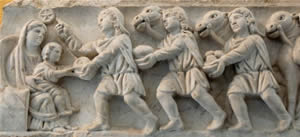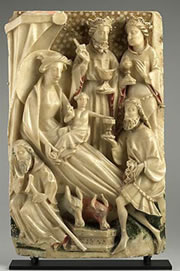Pagan Magi and Power Politics:
The "Disclosure" of Epiphany
For Sunday January 6, 2008
Epiphany
Lectionary Readings (Revised Common Lectionary, Year A)
Isaiah 60:1–6
Psalm 72:1–7, 10–14
Ephesians 3:1–12
Matthew 2:1–12
 |
Adoration of the Magi. Panel from a Roman sarcophagus, 4th century CE. From the cemetery of St. Agnes in Rome. |
In his recent commentary on Matthew (2006), Stanley Hauerwas of Duke observes that sentimentality is one of the greatest enemies of understanding the gospel, especially the Christmas story and the events surrounding the birth of Jesus. What parent hasn't gushed with pride watching his child play the part of a shepherd in a bathrobe or an angel with a coat hanger halo? I know that I have.
The gospel for this week disabuses us of all such Hallmark readings of the Bible. The story of the pagan magi worshipping Jesus ends in carnage when king Herod slaughters innocent children in order to strengthen his rule. This is an old story, retold many times in our own day, in which political powers annihilate their opposition to protect their power; it's certainly not a story that you'd want to teach with a flannel graph in a children's Sunday school.
The historical obscurity of the magi tantalizes our speculation. Many Bibles simply transliterate the word from the Greek text, magoi. Contrary to tradition, Matthew doesn't say that there were three of them. The Greek historian Herodotus (5th century BC) says that the magi were a caste of priests from Persia who could interpret dreams. That's good, because there are five dreams in Matthew's birth narrative, and four of them warn of the murderous intentions of king Herod and his son Archelaeus who succeeded him.
Others think that the ancestry of the magi reaches back to the Kurds two millennia ago. That would be a delicious irony in our modern geo-political context. By the third century, some people interpreted the magi as three kings, a reading which would include a clash of kingdoms: on the one hand, pagan kings who bow down to the newborn King of the Jews, and, on the other hand, the imperial king of Rome who tries to murder him.
On January 6 western Christians celebrate the feast of Epiphany, which takes its name from the Greek word epiphaneia, meaning disclosure, manifestation, unveiling or appearance. At the simplest level, on Epiphany Christians commemorate the "appearance" of the magi from the east. But on closer inspection, what are the ramifications of the baby in the manger? What does His birth manifest or unveil? What about the cosmic signs and the provocative language that this helpless baby is a newborn king? Will he really inaugurate a new reign and rule in which, according to his mother Mary, God will depose tyrants and send away the rich as empty-handed beggars?
The magi who traveled long and hard to worship Jesus with extravagant gifts remind us that He is not only the King of the Jews; he's the King of all nations and peoples. In contrast to our propensity to privilege one ethnicity or people (usually "mine") over another, to view one's own people as exceptional to God and others as at best unexceptional, and to exclude other people who are different (usually "yours"), the pagans from Persia show that God welcomes the worship and the gifts of all people everywhere.
 |
Adoration of the Magi, 15th century. |
This is especially noteworthy in Matthew's gospel because he wrote for a specifically Jewish community. For example, he incorporates far more Old Testament quotes than the other Gospel writers, using the formula “that it might be fulfilled” some fourteen times. One early tradition even believed (wrongly) that he might have written in Hebrew. So, while Matthew focuses on Jesus as King of the Jews and the fulfillment of Israel's history, the magi are a poignant reminder that Jesus welcomes all peoples from all places.
This was a bitter lesson for early believers, who at first were all Jewish and who knew that they were the elect of God — the shocking idea that impure Gentiles were, from God's perspective, on equal footing with them. This is Paul's point in this week's epistle (Ephesians 3:1–12). His ministry, he writes, is “for the sake of the Gentiles,” but for long ages past this has been a “mystery” (a word he uses three times here). In Jesus this mystery has now been revealed, “that through the Gospel the Gentiles are heirs together with Israel, members together of one body, and sharers together in the promise in Christ Jesus” (Ephesians 3:6).
The magi, then, "unveil" this mystery and disclose the nature of God's kingdom announced in Jesus. They remind us that it cannot be limited to the Jews or any other singular people. The magi symbolize the divine promise given to Abraham for "all peoples on earth" in the first book of the Bible (Genesis 12:3), and John's vision of heaven with people from "every nation, tribe, people, and language" in the last book of the Bible (Revelation 7:9). And this is only the beginning. The new king Jesus abolishes not only the barriers of nation, race and ethnicity. He also transcends the boundaries of gender, religion, economics and social stratification, for in Christ “there is neither Jew nor Greek, slave nor free, male nor female, for you are one in Christ Jesus” (Galatians 3:28); the magi were only the tip of a very big iceberg.
Whereas the magi of Persia worshipped the baby Jesus, Herod of Rome tried to kill him. We don't normally associate the birth of a baby with the demise of political power, but Matthew does. His political parody is writ large. And at least we can give credit where it's due; Herod knew a genuine threat to his power when he saw it. Matthew contrasts two rival kings who rule not only over one people (the Jews) but over all the world. One king must give way. The subplot of king Herod almost overshadows the main plot of the adoration of the magi.
The magi came to worship Jesus (2:2), and that's what they did. Upon seeing Jesus and Mary, “they bowed down and worshipped Him,” offering him gifts of gold, incense and myrrh. Herod tells his confidants that he too wants to worship Jesus (2:8), but that's a lie. Matthew says that when king Herod heard the news of another king he responded in fear, paranoia, and eventually infanticide.
Herod "the Great" (c. 73–4 BC), as he was known, had been given the title “King of the Jews” in 40 BC, and after consolidating his power he ruled over Judea for 33 years (Luke 1:5). The last thing he wanted was a rival over his Judean domain. So suspicious and insecure was he that he called a secret meeting of religious leaders and extracted information about the exact time and place of the birth of the new king, Jesus, knowledge that would later prove lethal.
After worshiping Jesus, the magi set out to return to their country. But God warned them in a dream not to return to Herod, who had demanded that they come back with precise information. They disobeyed Herod and returned home “by another route.” When he learned that the magi had tricked him, Herod erupted in a furious rage and murdered all the male children two years old and younger who lived in Bethlehem and its vicinity.
Meanwhile, Mary, Joseph and the baby Jesus fled to pagan Egypt where they found asylum. That symbolic place of Israel's bondage now became a place of protection. In the end, it was king Herod the Great who died, about 4 BC, not the baby Jesus. King Jesus returned to settle in the town of Nazareth in the district of Galilee, although he was careful to avoid Herod's son Archelaus who took his place.
 |
Adoration of the Magi (detail) by Nicola
Pisano, c. 1259–60; part of the marble pulpit in the Baptistery at Pisa. |
There are, in fact, five Herods in the New Testament, and to a person they all persecuted Jesus and the early church. In addition to Herod the Great, there is his older son Archelaus born of his wife Malthace (Matthew 2:22), who reigned only a few years and was deposed in 6 AD. Then there's Herod's younger son by Malthace, Herod the tetrarch (Luke 3:19), who is famous for murdering John the Baptist on a dinner party dare because John denounced his affair with his brother's wife (Mark 6:14–29), and for his encounter with Jesus at his trial (Luke 23:7). Fourth, there's Herod King Agrippa (Acts 12:1), the grandson of Herod the Great, who murdered James and tried to murder Peter (Acts 12:1ff). Finally, there's King Agrippa's son, also named Agrippa, who bantered with Paul amidst great pomp and exclaimed that Paul was trying to convert him (Acts 25:13–26:32).
All these Herods do the opposite of the magi; they work hard to make the subversive kingdom of Jesus subservient to the political power of the state. But these Herods, whether ancient or modern, are right about one thing; if Jesus is Lord, then Caesar is decidedly not lord.
For further reflection:
* Who might be our contemporary magi?
* Who might be our contemporary "Herods?"
* How do we exclude pagan magi today?
* What are the ways that we bow to "Herod" today?
* Can you think of how the magi further "disclose" the nature of pagan religion and power politics?
Image credits: (1) Wikipedia; (2) Minneapolis Institute of the Arts; and 3) Encyclopedia Britannica.





